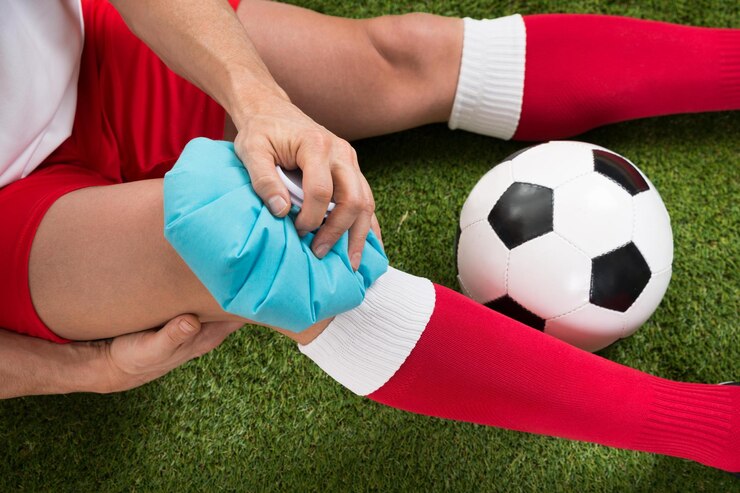Football is a famous game, known for its speed, intensity and physical contact. With constant changes in the move and sudden stops, one can experience various kinds of physical injuries during the game, which makes the players to be prepared for the worst on the field. The key is to know everything about the common football injuries and how to avoid them.
The Reality of Football Injuries
Injury can be in the form of minor sprains or can be as severe as tear of ligaments. Some are caused by lack of good technique, some because of overuse, many because the game is physical. However, a large portion of professional football training has nothing to do with creating fitness or skill development – it is more about avoiding stumbling blocks that may cause a halt to progress, or even the end of a career.
Ankle Sprains
Ankle sprains are very common in football. They commonly occur if a player falls in an awkward position or trips over uneven ground, or gets tackled. Even though most sprains are relatively mild, neglecting them can cause long term chronic instability or cause serious injuries in the future. Prevention begins with building the muscles around the ankle and making balance better. It’s equally important to make the right choice of boots on the playing surface and the pre-warm-up and mobilisation of ankles before getting on the field.
Hamstring Strains
Hamstring injuries are common in attacking players who are dependent on burst speed. These muscles are prone in sudden sprints or overstretching and usually take players by surprise during acceleration or lunging. To lower the risk, in professional football training programs, there is emphasis on eccentric hamstring exercises which have proven to reduce the injuries by significant percentages such as in Nordic curls. Dynamic stretching and progressive sprint drill warm-ups are essential too.
Knee Ligament Injuries
One of the most dreaded injuries in football is the ligament ones relating to the knee, and especially the anterior cruciate ligament (ACL). Such injuries are usually caused by twisting movements, awkward impacts or a direct impact. It may take months to recover and for some players, a torn ACL can end the competitive career in football. ACL injuries prevention does not purely rely on strong legs. Players require good coordination, core strength and correct mechanics with regards to jumping, which is only possible when you choose the best football club in India.
Groin Pulls and Hip Issues
Footballers are constantly swerving, stretching and twisting-movements heavily utilizing groin and hip regions. Hip groin strains may be chronic and maddening, especially if it keeps coming back once it is not treated and prevented right away. Professional football training should ensure to improve the adductors, enhance hips’ mobility and involve side-by-side movement drills. Players also should know their limits and not force through minor forms of discomfort.
Shin Splints and Overuse Injuries
Very common with the younger players or those playing on hard surfaces, shin splints are characterized by the inflammation of the muscles surrounding the shinbone. The pain is variable between mild to debilitating. The better protection is a reasonable training plan which does not include a dramatic increase of running volume. The choice of footwear, choice of the surface, and focus on lower-leg strengthening also make a great deal of difference. Coaches at the best football club in India must regulate the training loads to stave off these kinds of problems from developing into greater problems.
Achilles Tendonitis and Other Tendon Issues
Tendonitis especially, in the Achilles tendon, tends to develop from overuse or poor recovery. It may lead to long term pain, which interferes with running, jumping and changing direction actions, all vital movements in football. Injury prevention strategies are calf strengthening, mobility work, and structured rest days. Players should also make sure their heel is supported by their training shoes and not too hasty in returning to full activity after a knock.
Building a Culture of Prevention
The prevention of injury has nothing to do with the role of a medical staff – it’s a team working. The coaches must schedule training sessions which have a balance between intensity and recovery. Players will have to own fitness and wellness. And clubs regardless of the level should create a culture in which injury prevention becomes a part of everyday culture.
The way of treatment of football players’ injuries in India is getting more sophisticated as football develops in this country. Not only the best football club of the country is an example to follow but of course they are an example by combining the old knowledge and new sports science allowing their players to become healthy, strong and on top of that match-ready.
Conclusion
Injuries are a very common part of football but they can be reduced with proper approach. The focus of a professional coach should be on prevention along with teaching the young player with the ways to deal with them. If you are getting ready for the next game in your local championship or if you are planning to play at the top level, keep in mind – health is your greatest capital in football. Take care of it, train smart and play with confidence.





